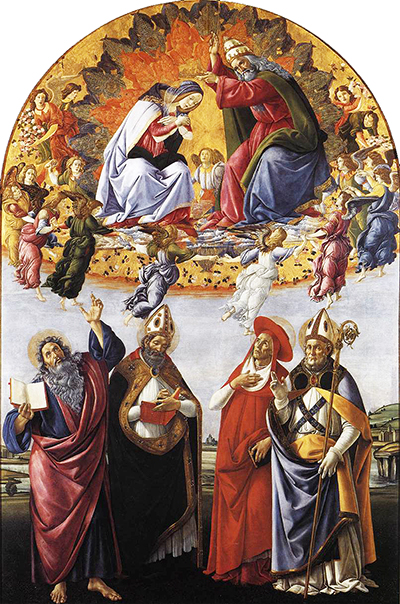This huge painting was produced by Sandro Botticelli in circa 1480. It captures the famous religious scene of the Coronation of the Virgin and features nearly two dozen figures across the full expanse of this piece.
The huge scale of this artwork suggests that Botticelli may well have called upon the services of his assistants in order to complete this piece. It is over three metres in height and two and a half metres in width, making it one of his largest ever. The artist used tempera here, which was entirely typical of his career. The artwork can now be found within the highly prestigious Uffizi gallery in Florence, which was the hometown of the artist as well. Whilst most point to the early 1480s, others have since suggested that this painting may actually have arrived slightly later in the 1490s and it is hard today to really prove or disprove either of those suggestions. Even with all of the scientific research tools that now exist it is very difficult to differntiate between decades for events that happened so many centuries ago, particularly when Botticelli's own career was not really investigated in detail until as recently as the 19th century.
Artist Botticelli produced this painting for the church of the Dominican monastery of San Marco in Florence. It would be the guild of goldsmiths specifically who were involved in planning the interior of the church who ultimately commissioned the piece and it is currently the largest painting by Botticelli that still exists today. Their role as goldsmiths perhaps explains why this colour is quite so dominant within The Coronation of the Virgin Altarpiece of St Mark as a means to featuring them within the design. We find a composition here which is separated very clearly into the top and bottom of the panel, representing the heavenly and earthly respectively. It was actually fairly rare to see the two together in the same painting within the Early Renaissance but would become commonplace in later centuries.
The four figures in the earthly section represent John the Evangelist, the Fathers of the Church St Augustine and St Jerome and St Eligius, with the overall piece actually being dedicated to the latter of those. This highly elaborate artwork then features a spawling landscape in the background though this is very much a supporting element, with so much detail added in the foreground within this highly complex, some say breathtaking artwork. Above the earthly figures we see God and the Madonna who are pictured themselves in typical fashion for this era. They are then joined by a whole series of other small figures who are placed all around that section of the piece.




